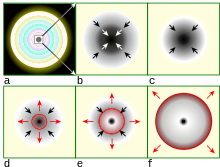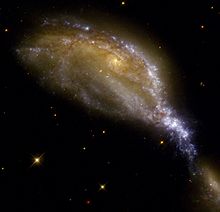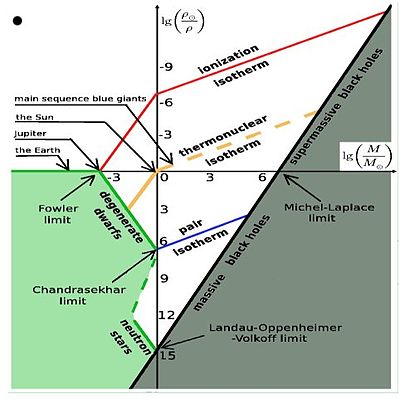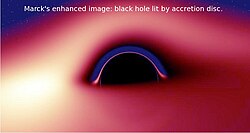Gravitational collapse
This article needs additional citations for verification. (October 2009) |

Gravitational collapse is the contraction of an
As a clandestine form of gravitational collapse, the gradual gravitational collapse of
Star formation
An interstellar cloud of gas will remain in
Stellar remnants

At what is called the star's death (when a star has burned out its fuel supply), it will undergo a contraction that can be halted only if it reaches a new state of equilibrium. Depending on the mass during its lifetime, these stellar remnants can take one of three forms:
- White dwarfs, in which gravity is opposed by electron degeneracy pressure[4]
- neutron degeneracy pressure and short-range repulsive neutron–neutron interactions mediated by the strong force
- Black hole, in which there is no force strong enough to resist gravitational collapse
White dwarf
The collapse of the stellar core to a white dwarf takes place over tens of thousands of years, while the star blows off its outer envelope to form a planetary nebula. If it has a companion star, a white dwarf-sized object can accrete matter from the companion star. Before it reaches the Chandrasekhar limit (about one and a half times the mass of the Sun, at which point gravitational collapse would start again), the increasing density and temperature within a carbon-oxygen white dwarf initiate a new round of nuclear fusion, which is not regulated because the star's weight is supported by degeneracy rather than thermal pressure, allowing the temperature to rise exponentially. The resulting runaway carbon detonation completely blows the star apart in a type Ia supernova.
Neutron star
Neutron stars are formed by the gravitational collapse of the cores of larger stars. They are the remnant of supernova types
The appearance of stars composed of
Black holes

According to Einstein's theory, for even larger stars, above the Landau–Oppenheimer–Volkoff limit, also known as the Tolman–Oppenheimer–Volkoff limit (roughly double the mass of the Sun) no known form of cold matter can provide the force needed to oppose gravity in a new dynamical equilibrium. Hence, the collapse continues with nothing to stop it.

Once a body collapses to within its Schwarzschild radius it forms what is called a black hole, meaning a spacetime region from which not even light can escape. It follows from general relativity and the theorem of Roger Penrose[8] that the subsequent formation of some kind of singularity is inevitable. Nevertheless, according to Penrose's cosmic censorship hypothesis, the singularity will be confined within the event horizon bounding the black hole, so the spacetime region outside will still have a well-behaved geometry, with strong but finite curvature, that is expected[9] to evolve towards a rather simple form describable by the historic Schwarzschild metric in the spherical limit and by the more recently discovered Kerr metric if angular momentum is present. If the precursor has a magnetic field, it is dispelled during the collapse, as black holes are thought to have no magnetic field of their own.[10]
On the other hand, the nature of the kind of singularity to be expected inside a black hole remains rather controversial. According to theories based on
Theoretical minimum radius for a star
The radii of larger mass neutron stars (about 2.8 solar mass)[13] are estimated to be about 12 km, or approximately 2 times their equivalent Schwarzschild radius.
It might be thought that a sufficiently massive neutron star could exist within its Schwarzschild radius (1.0 SR) and appear like a black hole without having all the mass compressed to a singularity at the center; however, this is probably incorrect. Within the
See also
References
- ISBN 9783642340239.)
{{cite book}}: CS1 maint: multiple names: authors list (link - ISBN 1-891389-46-7.
- ISBN 0-521-65937-X.
- ^ And theoretically Black dwarfs – but: "...no black dwarfs are expected to exist in the universe yet"
- ISSN 0163-8998.
- ^ Carroll & Ostlie 2017, p. 578.
- S2CID 119508131.
- ISSN 0031-9007.
- ISSN 0031-9007.
- S2CID 15869680.
- ^ Thorne, Kip S. (1966). L. Gratton (ed.). The general-relativistic theory of stellar structure and dynamics (PDF). Proceedings of the International School of Physics “Enrico Fermi”, Course XXXV. Varenna, Italy: Academic Press, New York. p. 273.
- S2CID 118917980.
- ^ "Bhatia Hazarika limitの意味・使い方・読み方 | Weblio英和辞書".
- PMID 10021057.
Bibliography
- Carroll, B. W.; Ostlie, D. A. (2017). An Introduction to Modern Astrophysics (2nd ed.). ISBN 978-1-108-42216-1.

